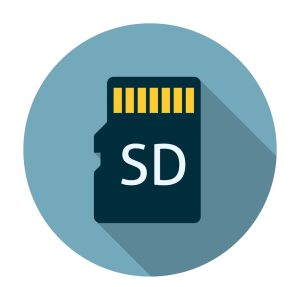SD, which stands for “Secure Digital,” refers to a proprietary, non-unstable flash reminiscence card layout developed via the SD Association (SDA). These compact and versatile storage cards are designed for use in an extensive variety of transportable electronic gadgets.

History of SD
- Introduced in 1999 by the SD Association (SDA) for portable devices.
- Rapid adoption due to small size and compatibility.
- Evolution to higher capacities with SDHC (up to 32GB) and SDXC (up to 2TB).
- Introduction of speed classes for data transfer.
- MiniSD and MicroSD variants for smaller devices.
- Enhanced security features added.
- Ongoing advancements, including UHS classes for faster speeds.
- Facing competition from newer storage technologies like SSDs and cloud storage.
Advantage of Secure Digital
Secure Digital (SD) cards have several advantages:
- Compact & Portable: Small and lightweight, easily fit into various devices.
- Wide Compatibility: Work with many devices like cameras, smartphones, and laptops.
- High Capacity: Available in various sizes, including large-capacity SDXC cards.
- Fast Speeds: Support for high-speed data transfer, vital for HD video recording.
- Durability: Designed to withstand shocks, some are even water-resistant.
- Security Features: Offer write protection, password protection, and data encryption.
- User-Friendly: Plug-and-play, no complex setup required.
- Reliable: Known for data integrity and minimal corruption risk.
- Cost-Effective: Provide cost-efficient storage options.
- Expandable Storage: Ideal for devices with limited internal memory.
Disadvantage of Secure Digital
Certainly, here are the disadvantages of SD cards in simpler and shorter terms:
- Limited Lifespan: SD cards wear out over time with repeated use.
- Data Corruption Risk: Data on SD cards can get corrupted if not handled carefully.
- Storage Limits: They may not suffice for users with large data needs.
- Compatibility Issues: Older or budget devices may not support them.
- Security Not Foolproof: Security features aren’t always foolproof.
- Costly per GB: They can be pricier per gigabyte compared to other storage.
- Not Ideal for System Use: Not the best choice for system or software use.
- Risk of Loss/Damage: Small size makes them easy to lose or damage.
- Limited Mobile Use: Some mobile devices may not support them.
- Speed Variability: Speed varies between brands and models.
Important uses of Secure Digital
Secure Digital (SD) cards have important uses:
- Cameras & Camcorders: For photo and video storage.
- Mobile Devices: Expanding storage in smartphones and tablets.
- Computers: Data transfer and additional storage.
- Gaming Consoles: Expanding game storage.
- Dash Cams & Action Cameras: Storing footage.
- GPS Devices: Map updates and data storage.
- Audio Recorders: High-quality audio recording.
- Printers & Scanners: Saving and printing documents.
Conclusion
In conclusion, Secure Digital (SD) cards have played a significant role in the world of digital storage. They have evolved over the years to offer high-capacity, fast data transfer, and compatibility with a wide range of devices. Their compact size and reliability have made them a popular choice for storing photos, videos, music, and data in various applications, from digital cameras and smartphones to medical equipment and industrial machinery.
FAQ's About SD
There are several types of SD cards, including SD (Standard Capacity), SDHC (High Capacity), and SDXC (eXtended Capacity) cards.
The main difference is the storage capacity they offer. SD cards have a capacity of up to 2GB, SDHC cards offer up to 32GB, and SDXC cards can have capacities exceeding 32GB, going up to 2TB.
Speed classes, such as Class 2, Class 4, Class 6, and Class 10, indicate the minimum write speeds in megabytes per second (MB/s) for the SD card.
MicroSD cards are smaller versions of SD cards and are commonly used in smartphones and tablets.



















